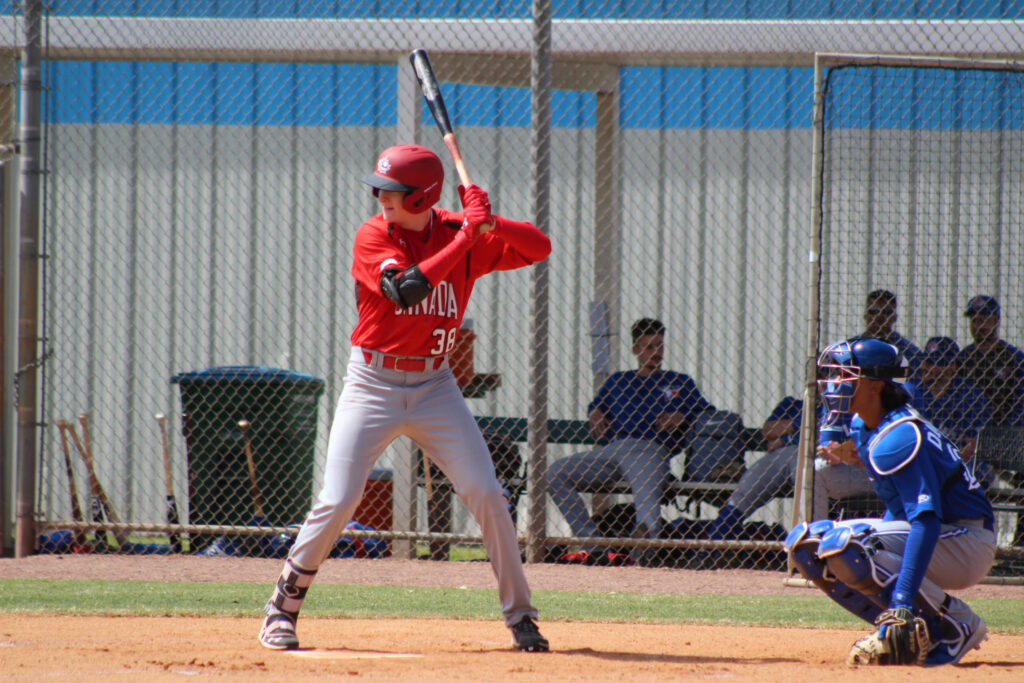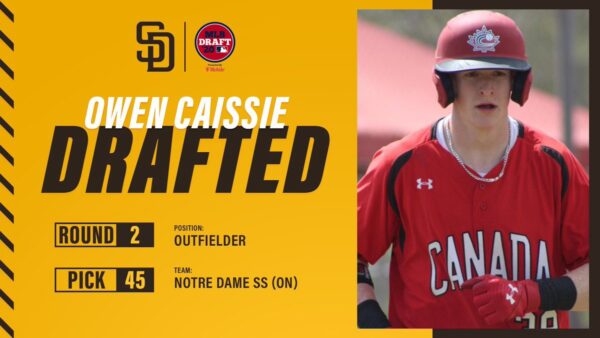Grading the Padres’ 2020 Draft: Owen Caissie

Credit: CBN

Taking a look at Owen Caissie, who the San Diego Padres drafted earlier this month.
Every year in the draft, there is some highly athletic kid with five-tool potential but in need of hitting refinement.
These players often present the most interesting profiles and represent the most alluring talents available. It is awfully hard to refrain from selecting them.
Luckily, Padres’ general manager A.J. Preller and his team have been undeterred in selecting amateurs with this type of potential; for example, they selected under-scouted Hudson Head in the third round of last year’s draft.
Based on the early results, a .283/.383/.800 triple-slash line with one home run and three stolen bases at the rookie ball level, Head was a steal. Many foresee a future in which the recent high school graduate becomes a 20/20 player with solid hitting and defensive contributions in the lineup. A few have even premature gambles that Head will be among the top thirty prospects after a healthy and full minor league season. His case illustrates how highly athletic but somewhat raw players are risks that can pan out incredibly. Due to Head’s success, the Padres chose Owen Caissie, a man of similar skills, in the second round of the recent 2020 draft. Only time will tell whether a gamble on Canada’s Zac Veen, according to many baseball news outlets, was a smart one. However, how does the pick look right now? Well, to answer that question we have to look at Cassie’s story and the abilities he brings to San Diego.
Owen Caissie hails from Notre Dame Catholic High School in Burlington, Ontario, Canada and was the first athlete from north of the border to be taken by a major league team. He accomplished this minor feat by exhibiting the best array of tools. His most recognized one is his power.
Throughout his high school years, Cassie exemplified easy power from the left side. There is nothing in his profile that does not scream plus power at the highest level. In fact, everything about him points north in this respect.
At the age of 17, he displayed an exit velocity of 105 mph. For someone who is not a fervent fan of baseball, this statistic does not mean much. However, Joey Gallo, a contender for being the premier power hitter in the major leagues, carried an average exit velocity of 93.0 throughout the 2019 season.
Some may argue that the two figures do not correlate well and therefore does not signify how strong the young Canadian is. However, the kid has not fully developed yet, so the fact that he can swat balls at an exit velocity near the levels of major leaguers, whether per contact or on average, is impressive.
Furthermore, the high school outfielder resembles a giant when comparing his strength to his peers. While Caissie was slamming balls at exit velocities approaching triple digits, the average high schooler was tapping pitches at an average exit velocity of 78.7 mph, at least according to prepbaseballreport.com. As a result, when writers, such as Robert Morrison of Last Word on Baseball and Alex Sanchez of Prospects1500, cite Joey Gallo as a comparable player to the Ontarian there is enough proof to suggest that neither writer is being outlandish.
In addition, the youngster’s build is similar to Gallo’s when he was drafted by the Rangers in 2012. Both athletes stood at 6’ 4” tall and weighed in at around 200 pounds when they were selected. This contributes to similar swings. The two outfielders utilize an open position, busy hands pre-swing, an elevated swing path, and a tendency to turn their numbers to the pitcher prior to cutting through the zone. Even the torque is parallel with one another.
Therefore, the comparison to Joey Gallo has its merits. If Caissie becomes anything akin to Gallo, the Padres have a huge steal on their hands. Just imagining the explosiveness Caissie could bring to Petco Park is jaw-dropping.
Besides the power, Caissie also possesses above-average speed. Usually power hitters with comparisons to Joey Gallo do not have game-changing speed; however, Caissie bucks this trend. Rated as a 55 runner, the University of Michigan commit is “at least an above-average runner, one who gets to plus once underway” (MLB.com). I say game-changing because even MLB.com concedes that the 17-year-old could be a centerfielder in the majors.
Although the initial assumption is that the Padres will develop Caissie as a righfielder, owing to his power at the plate and strong arm in the corner, San Diego ought to give the young gun a chance at position eight. When developing talent, a system should give its players an opportunity to succeed at the most important and valuable positions before either transferring them to a more comfortable position or utilizing them elsewhere in deference to more capable teammates.
The 2nd round pick is also no slouch on defense, staying true to his five-tool potential. Although a capable centerfielder, many list the Ontario native as a right fielder, especially since he routinely played that position on the Canadian junior national team.
Also, he has stellar arm strength. MLB.com places a 60 grade on his arm, stating how he consistently delivers “low-90s throws from the outfield.” Having that arm in center, if the Padres’ decide to try him there first, would be a huge asset to the team.
However, in his current position, Caissie could adequately fill in the gap left by the departure of Hunter Renfroe, at least in terms of arm strength. Moreover, his fielding is not shabby either. Although not at the level of his arm, Caissie is an average fielder who gets great jumps, due to his plus speed on the run, and takes well-thought routes to the ball. Such glovework is why he is not automatically designated as a right fielder. He has the chops to possibly stay in center if the need arises. These assets will make him a plus resource on defense.
MLB Pipeline lists his hitting ability as a 45. Such a grade is common among uber-talented high schoolers who could be five-tool threats. Even when a team picks such a player in the first round, there are questions regarding contact ability. For example, Austin Beck was selected 6th overall in the 2017 draft by the Oakland Athletics despite legitimate questions about his ability to put the ball into play on a consistent basis. Even Hunter Bishop of last year’s draft, who was taken 10th overall by the San Francisco Giants, was surrounded by doubts about his potential for a high average, and he was a college student.
Owen Caissie has an outstanding work ethic. Numerous reports considering him have noted that he spends numerous hours every day on the tee or constantly analyzing video of successful players in the pro ranks. One area which he could improve is exploring the success of not only power-hitters, which he primarily does, but also great left-handed contact hitters such as Jeff McNeil and Michael Brantley. He has already shown the ability to emulate the power that he sees on video of power-hitters, so studying superb contact hitters from the left side would go a long way in alleviating the anxieties regarding his hit tool. Either way, it is incredible how well he can translate what he sees on video to how he performs.
One of the best hitters in baseball history, San Diego’s own Tony Gwynn, became a Hall of Famer because of his constant work on the tee and behind video. In fact, he was one of the first to utilize video as a means of improvement at the dish. For Caissie to do the same every day speaks loudly about his extremely hard work ethic. As a result, there should be less problems when he receives professional coaching, notably because he is good at making adjustments already according to MLB Pipeline.
It is highly unlikely he ever reaches Gwynn’s production, but he can definitely improve to a point where his other tools makes him at least an above-average regular.
Also limiting the risk is where the Canadian was drafted. Listed as the 75th best prospect in the 2020 MLB First-Year Player Draft. Caissie’s bat is not projected to hit like a 2nd rounder should. Yet, he could easily surpass the estimates at a discounted price.
Grade: B+
I write, I write, and then I write some more.. Lifelong Padres & Chargers fan who is tired of the acceptance of losing that grips all of San Diego sports fans!
Thanks to all my readers and thanks for all the comments!
Time will tell. Just like Quantrill v Groome, Liberatore v Weathers, now it will be Hassell v Veen w a Caissie kicker.
I would say another kicker is Cole Wilcox since the Padres saved money with Hassell and reallocated to Wilcox. However, the Padres have been conservative in the draft since Preller (e.g. Quantrill, Weathers) and its bitten them in the back. However, I think Quantrill, for the time being, is better than Groome. Groome hasn’t made much progress towards the majors. I’m still mad about the Weathers situation. There’s no reason why Preller should have touched him with a ten-foot pole. Weathers definitely didn’t deserve the 7th overall selection.
Jim Callis said that, “you could say Cassie is the Canadian version of Zac Veen”. With all the hub bub about Veen, that is high praise. As soon as Wilcox puts pen to paper, this is going to be one heck of a draft haul for the Padres.
I could see Caissie as the Canadaian Zac Veen as far as power goes. However, the similarities end there for me. Veen is a much better contact hitter while Caissie is much faster and has a better chance of staying in centerfield even though the Padres aren’t going to play him there.